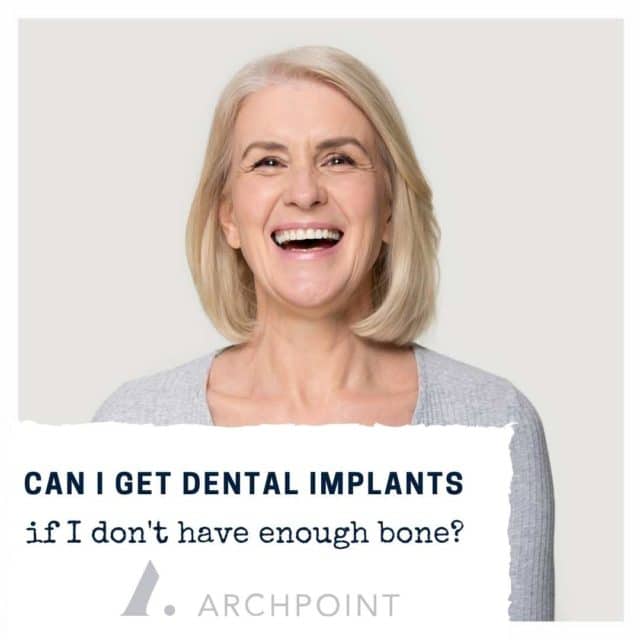Dental implants are one of the most successful and predictable ways to replace missing teeth. But in order for dental implants to be effective, they need to have a sound, stable foundation supporting them. In this case, healthy, dense bone.
Since bone is what anchors and fuses to the surface of dental implants, a person needs to have enough of it (bone) before their dental implants can be installed. Otherwise, the implant would protrude through the soft tissues or rupture a nasal sinus cavity. If the bone is too short, the implant would extend above the gums or be too loose to withstand normal biting and chewing forces.
Is it possible to get dental implants if you don’t have enough bone? Although the short answer is “it depends,” the longer version is that yes, you can get dental implants if you don’t have enough bone, as long as you work with an implant specialist who offers services such as grafting or zygomatic dental implant designs.
“What if I Don’t Qualify for Dental Implants?”
There are typically two major reasons why someone might not qualify for dental implants. One is an active oral disease, such as periodontitis. Fortunately, gum disease can be stabilized, especially if the diseased teeth are being removed or you’re working with a periodontal specialist. The other is not having enough bone to support a traditional dental implant. The keyword here is “traditional.” There are still alternative solutions available to make dental implant therapy possible, such as augmentation (bone grafting) or incorporating zygomatic dental implants that are set in a different area of your mouth.
Why You Need Healthy Bone for Dental Implants
Every type of dental implant — whether it’s traditional, mini, or zygomatic — relies on a process called “osseointegration.” Osseointegration is where your body recognizes the dental implant surface and is naturally attracted to it. In turn, your mouth forms a new, fine layer of bone attachment between the jaw and the surface of the dental implant. Without this fusion process occurring, the implant will not stay in place. But for full integration to even happen in the first place, you need to already have a bony socket surrounding the implant the same way you would for a natural tooth.
Unfortunately, tooth loss also naturally triggers bone loss. As does periodontal disease. Waiting a long time to replace your missing teeth means that you’re fighting against additional bone loss. Even if you’ve been told that dental implants aren’t an option for you, we highly recommend speaking with our implant specialists in Fort Worth and Dallas. Chances are, there will still be options that you can consider.
Dental Implants When You Don’t Have Enough Bone
“Can I get dental implants if I don’t have enough bone?” As long as you’re open to alternative implant designs and treatments, yes! At ARCHPOINT, our implant specialists may recommend one of the following strategies:
Placing a bone graft. Bone grafting (augmentation) helps to naturally build out a healthier, denser, stronger bone for your dental implant to set inside. Once a bone graft is placed, it begins to integrate with your current bone and helps restore areas of your jaw that resorbed (shrunk).
Changing the location of your implant installation site. Depending on which teeth are missing and how many need to be restored, dental implants don’t necessarily need to go in a specific area of your jaw. It may be possible to slightly alter where they’re installed, moving it forward or backward in your jaw, or even inserting it at an angle to take advantage of the healthy bone you already have.
Switching to an alternative implant design, such as zygomatic dental implants. Zygomatic dental implants are designed specifically for people with extensive amounts of bone loss who might not otherwise qualify for dental implants. These special treatments use a longer implant design that’s set at an angle inside of your mouth, reaching into your zygoma or “cheekbone.”
Zygomatic vs. Traditional Dental Implants
A traditional dental implant closely resembles the size and shape of an anatomical tooth root. And most noticeably, it’s set into the bone of your jaw in a nearly identical fashion to natural teeth. On the other hand, Zygomatic dental implants are longer and installed at an angle. They are not restricted to the bone in your immediate jaw but reach up into your zygomatic arch, which is the bony area that makes up your cheekbone. Since it’s much longer, a Zygomatic implant can take advantage of other bone structures around your mouth, making them extremely useful when you might not otherwise qualify for dental implant treatment (because of bone loss.) They’re designed to expand the criteria for dental implants. But if your dentist doesn’t offer Zygomatic implant designs, they may still tell you that you don’t qualify for implant treatment.
Can I Replace All of My Teeth with Zygomatic Dental Implants?
Yes. Zygomatic dental implants can be paired together, just like traditional dental implants are. Our DFW implant specialists can place as few as four dental implants total, using them to permanently anchor a prosthesis such as an “All-on-4.” All-on-4 is a hybrid full-arch design that replaces all of your upper teeth at one time with the support of only four dental implants underneath.
Getting zygomatic dental implants in DFW can be hard if you’re not sure who to ask. Only specialists and implant experts such as the team here at ARCHPOINT usually offer this expanded service. Since our facility is equipped with state-of-the-art technology and a team of dental specialists, we’re able to provide care that’s beyond the traditional scope of a DFW dental implant office.
Expanding Dental Implant Services to More People
ARCHPOINT Implant Dentistry understands that not everyone fits the same criteria when it comes to replacing missing teeth. While many DFW implant providers offer traditional restorations, ARCHPOINT is one of the only specialists in the Fort Worth and Dallas area to provide advanced services like Zygomatic dental implants. Contact us today to reserve a consultation.








